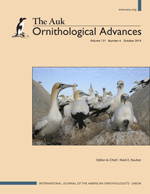Northern South America is a geographic bottleneck that may be limiting the survival of Nearctic–Neotropic migrants. However, very little is known about the migration ecology of transcontinental migrants wintering in South America. We studied the fall migratory strategies of three species of thrush (Catharus ustulatus, C. fuscescens, and C. minimus) at 2 major migrant gateways into South America: the Darién and the Sierra Nevada de Santa Marta (SNSM) of northern Colombia. Assuming that migration route shapes the stopover strategy of birds and that our sites receive birds from 2 different routes, we predicted that (1) migrants traveling over land through Central America (Darién) would make short and frequent stopovers followed by short flights and (2) migrants crossing the Caribbean (SNSM) would make few and long stopovers to acquire fuel for longer flights. To test these predictions, we estimated condition on arrival, stopover duration, fuel deposition rates, and potential flight ranges after stopover, using 3 yr of capture–recapture data. Each species adopted a different stopover strategy, with Swainson's Thrush arriving in South America through the Darién, making the shortest stopovers and achieving the shortest flight ranges (800 km); Gray-cheeked Thrush arriving primarily through the Darién, making short stopovers but achieving longer flight ranges (1,200 km); and Veery arriving in both the Darién and the SNSM, making the longest stopovers and achieving the longest flight ranges (1,900 km). Our results suggest that stopover strategies are shaped by both migratory route (over land vs. over water) and distance to final destination in South America. Unraveling the breeding origins and wintering destinations of individuals passing through northern Colombia would greatly improve our understanding of hemispheric migration systems and will be critical if we are to protect the most important stopover sites and habitats.
How to translate text using browser tools
17 September 2014
Fall stopover strategies of three species of thrush (Catharus) in northern South America
Camila Gómez,
Nicholas J. Bayly,
Kenneth V. Rosenberg
ACCESS THE FULL ARTICLE

The Auk
Vol. 131 • No. 4
October 2014
Vol. 131 • No. 4
October 2014
fuel deposition rate
Gray-cheeked Thrush
migration
Neotropics
stopover
Swainson's Thrush
Veery




